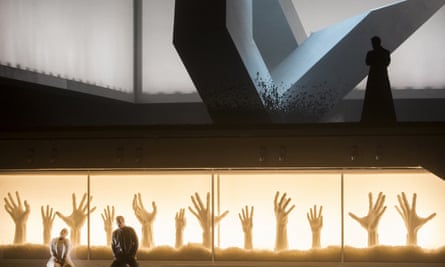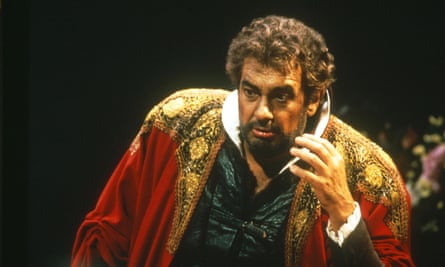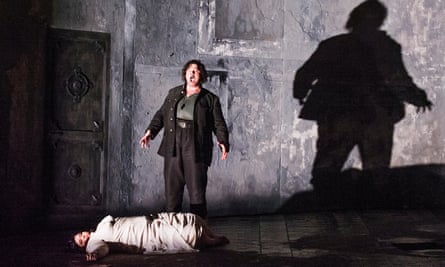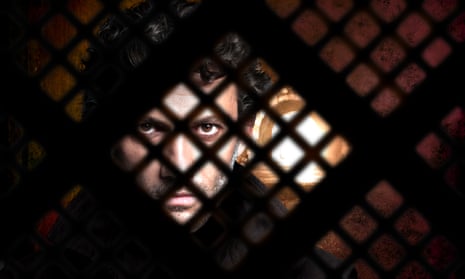German tenor Jonas Kaufmann makes his eagerly anticipated title role debut in the Royal Opera’s new production of Verdi’s Otello on 21 June. The audience’s only desire will be to “listen, transported” – like Desdemona – to Kaufmann’s opening salvo, Esultate. But audiences have eyes, too: opera directors, designers and managers will be scrutinising the makeup, costume and gestural personification of the Moor. Otello in 2017 raises an issue at once visual, ethical and extrinsic to the plot: the number of tenors capable of singing the virtuosic lead role has always been small; to this day, that list remains overwhelmingly white. How should the Royal Opera depict the “dusky” man whom Iago calls a “murky”, “thick-lipped savage”, when the white tenor’s skin evokes the “lily fairness” of Desdemona?
Until very recently, white opera singers cast as non-white characters had recourse to dark theatrical makeup. Keith Warner, who is directing Covent Garden’s new Otello, has roundly rejected this. “It’s about the audience making an imaginative leap,” he says in an interview on the Royal Opera House’s website. “And on top of all that, [blacking up] is of such offence to the black community in London and elsewhere.” Without the quick “fix” of makeup, opera artists seek stronger solutions for depicting the Moor’s identity: does he look like a man projecting his inner torment on to the world, a man hated for the colour of his skin, or both?
Boris Kudlička’s set renders Otello’s world as a claustrophobic black box, starkly lit. Both set and costume design create “an imagined collage of various periods, certainly Elizabethan, but also modern”, according to assistant director Julia Burbach. An expressionistic use of black and white might evoke, as it did for the Hungarian State Opera’s production in 2015, what its director, Stefano Poda, called “dualism as a tension between two halves of the world, not necessarily bad versus good, but maybe dream versus reality or … expectation versus destiny”.

Otello galvanises questions of race and identity because the opera has historically dramatised not Moorishness but whiteness: white artists’ imaginations, designs and strategies for depicting, eliding or aggravating racial conflict, both in the plot and backstage. When Verdi was composing what he referred to as the “chocolate project”, he wrote: “You can hardly have Otello dressed as a Turk, but why not have him dressed as an Ethiopian, without the usual turban?” But Verdi’s ethnic mishmash of a Moor had greater historic factuality than audiences might realise. Columbia University’s professor of medieval and early modern studies Jesús R Velasco points out that for centuries, Europeans applied the Latin epithet “Mauri”, later “Moors”, to racially diverse people – from north and sub-Saharan Africa, Sicily, Iberia and Asia as far as Baghdad. These included Muslims, Christians, converts and adherents of other religions. “Moors is a name that they did not use themselves, to name themselves,” he says. “It’s a name that somebody else used to name them.” Sometimes non-Moorish Europeans’ attitudes were Moorophobic, sometimes Moorophilic: from the 16th century, musical and theatrical paeans to the “good Moor” were popular, regardless of authors’ or fans’ feelings toward actual “Moors”.
Which brings us to Shakespeare’s day. In a nation that was preoccupied with colonisation, travel and an emerging white identity defined by contrast with blackness, the English literary imagination largely reduced Moorish ethnic distinctions to the figure of the black Moor, says Professor Kim F Hall, author of Things of Darkness and editor of Othello: Texts and Contexts.
In the earliest account (1693) and in engravings representing Shakespeare’s Moor as he was portrayed onstage, he is a white actor made up to look black. But the British slave trade had an impact on theatrical practice, making a blacked-up Othello controversial, because “it becomes very difficult for English people to see blackness and nobility coexisting”, says Hall.

Around 1814, the celebrated Shakespearean actor Edmund Kean inaugurated a shift away from the performance of blackness in Shakespeare’s play, and appeared in the role made up as a relatively light-skinned Arab Moor. As Hall points out, this “bronze age” of Othello was a response to slavery. “It’s a reaction to the fact that you no longer had the possibility, in the imagination, of black men being citizens, being even kind of elite outsiders. Slavery so taints the image of black men that it becomes kind of implausible. And then, as the century goes on … the way minstrel blackface trains audiences to laugh at characters makes it even less possible to portray Othello as black.”
In 1887, tenor Francesco Tamagno “blacked up” in makeup and a tightly curled wig to create the role of Verdi’s Otello. Well over a century later, the practice persisted in opera houses, long after Shakespearean actors had abandoned it. The Metropolitan Opera’s first unblackened Otello, Latvian tenor Aleksandrs Antonenko, was in a 2015 production.
For certain literalists, seeing a white singer in the role frustrates their desire to see Otello with textually correct atro tenebror (the “black darkness” in Boito’s libretto). But Peter Gelb, the Met’s general manager says it won’t be happening again, at least not under his watch. “If anything, I think putting dark makeup [on] in these days causes a distraction. It takes you away from the story, rather than keeping you in it, because people understand that it is not appropriate.” And not only in Otello. “When we revive Aida, we are not using dark body and face makeup, as we once did. And someday we’ll have a new Aida, and we’re only going to move forwards.”
Gelb preferred to talk about casting. “The Met has the largest stage of any opera house around. So, singers who sing on our stage – in particular, roles like Otello that require big voices – have to have bigger voices.” He has his eye on tenor Russell Thomas, who is black, and “who, as his voice grows, is thinking about and planning to sing Otello … It’ll be wonderful when we actually are able to cast an African American or a black person as Otello. But until that time comes, we will have white Otellos.”

In 2009, Graham Vick, artistic director of Birmingham Opera Company, directed Ronald Samm, the first black tenor to sing the role on stage in the UK, and found that doing so enlarged the opera’s artistic possibility. Vick, who had also directed Plácido Domingo in the role at La Scala, said that it would be, “in Birmingham, pointless and unthinkable” not to cast a black tenor. “Obviously, one frees up enormously in terms of what one could do with the piece.” Samm’s personal take on Otello took artistic risks in depicting pain, nobility, honour and violence, says Vick. “I felt that in a chilling and a horrifying way in Birmingham, in a way I have never felt in any another performance.”
David Alden’s 2014 production for English National Opera was the first to renounce Otello’s dark makeup altogether (David Freeman’s never-revived 1998 take for the company featured a lead with skin darkened to look “Mediterranean rather than black”, as the Guardian’s reviewer noted). Alden cast Australian tenor Stuart Skelton, who, dressed in black, was isolated and awkward, and sidestepped the issue with a production that was – as he put it in a programme note – “an interior portrait of Otello”.

Daniel Kramer, ENO’s newly appointed artistic director, eschews quick fixes in favour of the long view: creating an entire generation of diverse performers. For Kramer, that means education, expanding ENO’s programming to include diverse musical traditions, and employing diverse role models onstage and backstage, in “composing music, writing librettos, directing, designing, stage management, producing, as well as singing and conducting … We all want to and need to work together, to increase the pool of singers going to conservatories, to train in the arts professions, so that we have a larger selection of incredible talent to be featuring on our stages, so that audiences also see themselves reflected on stages.”
In the meantime, as opera continues to diversify, providing greater support and employment for singers of colour, we might await a production that takes the approach of theatre director Jude Kelly in 1997 with her “photo-negative” Othello, starring Patrick Stewart in the title role surrounded by a race-reversed black cast. For now, we might still imagine a white tenor as Otello, but surround him with black co-stars singing the roles of Desdemona, Iago, Cassio, filling the stage with a chorus of people of colour, who grapple with race, power and music in new ways, to inspire all the Otellos of the future.
- Otello is at the Royal Opera House, London, 21 June to 15 July. Box office: 020-7304 4000.
- Alison Kinney is the author of Hood (Bloomsbury).

Comments (…)
Sign in or create your Guardian account to join the discussion